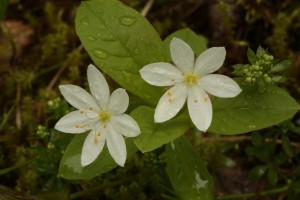
On Sunday 8th June, after spending more than two hours with an oak tree (Quercus petraea) and a young hazel (Corylus avellana) beside the road at the eastern end of Glen Affric, just above Badger Falls (see Part 1 of this blog), I drove a little further into the glen. As I often do, I stopped near Dog Falls, as I wanted to look at some aspen trees (Populus tremula) that are growing beside the road there, just at the falls themselves.
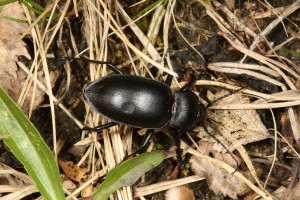
Almost as soon as I got out of the car some movement on the ground caught my eye – it was a large black ground beetle. I followed it for a few minutes, taking some photographs when it was fully visible, without being partially obscured by the vegetation. I noticed that it had a dimple on one of its elytra (wing cases), so when I emailed the photos to Richard Lyszkowski for identification, I also asked him about that. He replied that it was a common species (Carabus glabratus), and that when adult beetles emerge from their pupae, their elytra aren’t fully hardened for the first couple of days, and are vulnerable to damage, for example by squeezing into a crevice to escape from predators. Something like that must have happened to this individual.
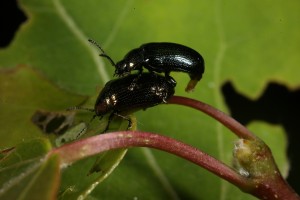
Reaching the aspens by Dog Falls, I began looking at the leaves of some of the young naturally regenerating trees, growing as suckers or ramets off the root systems of the mature ones. These are right beside the road, about 6 feet tall and quite bushy, making them ideal for searching for invertebrates on the leaves. In previous years I’d seen plenty of leaf beetles (Phratora vitellinae) on these aspens, and almost immediately I spotted some this day as well. I wrote extensively about this species in a blog earlier this year.
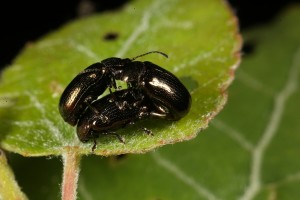
I came across a couple of these small, metallic coloured beetles just about to mate, and then on another leaf, I saw a ‘menage a trois’. There, a pair were in the middle of their coitus, but an intruding male was attempting to dislodge the male partner of the couple, and take his place. I watched their silent struggle for a few minutes, taking some photographs as I did so, but the situation didn’t change. The intruder wasn’t successful in dislodging the incumbent male, but neither were the mating couple able to evict their unwelcome guest.
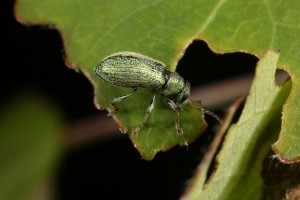
After another minute or two, I left them to their amorous drama and looked at another part of the same young aspen. It wasn’t long before I spotted another beetle, and this time it was the silver-green leaf weevil (Phyllobius argentatus) that I’d seen earlier in the day, on a hazel tree beside the road above Badger Falls. This one was on an aspen leaf that had been eaten, most likely by a caterpillar, judging from the shape that had been excised out of the leaf.
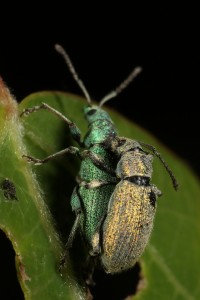
There is considerable colour variation in this species, and this was readily apparent when I spotted a mating pair on another nearby leaf.
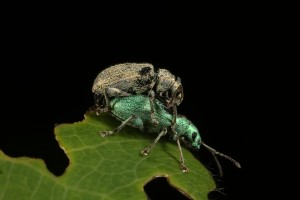
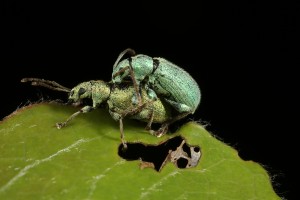
A copper-coloured male beetle was mounted on a brilliant turquoise green female, with both appearing iridescent and metallic in their coloration. After taking a few photographs of them, I looked at some other leaves on the same aspen, and discovered that there was an abundance of these weevils, with several different pairs mating in close proximity to each other. In one couple the colours of the male and female were the opposite of the first pair, with the male turquoise green, and the female a greenish-copper.
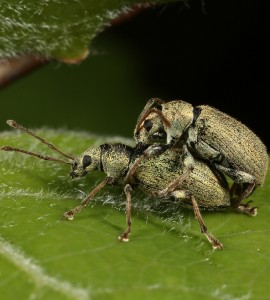
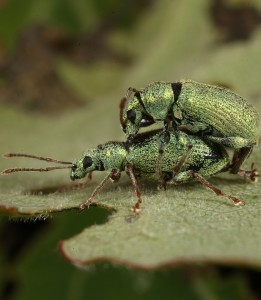
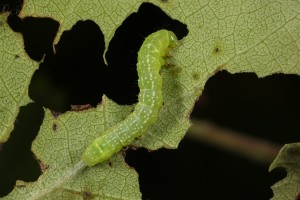
I then came across a couple of pairs in which both the males and females were the same colour in the pair, but different to those in the other pair. It seemed like a veritable technicolor beetle orgy on this young aspen! On another leaf there was a small caterpillar munching its way quite extensively, and when I checked with Roy Leverton, he thought this was probably also a young caterpillar of the common quaker moth (Orthosia cerasi), which I’d seen earlier in the day on the oak tree near Badger Falls.
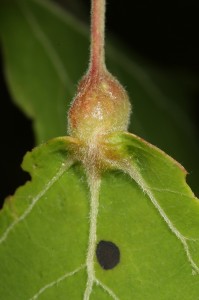
On an adjacent young aspen my attention was drawn by a gall at the base of leaf, where the petiole or leaf stem joins the leaf blade.
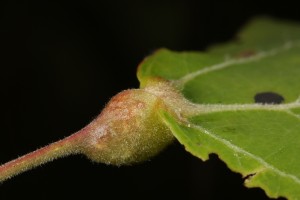
I didn’t recognise this gall. It wasn’t the aspen petiole gall that is caused by a midge (Contarinia petioli), and the gall is smooth (not hairy like the one I’d found) and also it occurs on the petiole itself, not partially on the leaf blade. Another possibility is a mite (Eriophyes diversipunctatus), which induces galls at the junction of aspen petioles and leaves, but they consist of paired chambers, whereas this looked like a single structure. I sent the photos to a couple of gall experts, neither of whom were able to make a definitive identification, and one of them said it would be necessary to collect the specimen and cut the gall open to see the shape and structure inside. I hope to return to Glen Affric to do that in the next week or so.
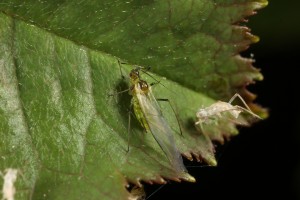
Moving on again, I went to the Loch Beinn a’Mheadhoin picnic site, a little further west. When I’d been there a few weeks previously, I’d found some aphids on a dog rose plant (Rosa canina). I’d sent them to Ed Baker, the aphid specialist, but he’d been unable to identify them as they were all immature individuals then, and he’d suggested returning in a few weeks to look for winged adults, which is what I was planning to do this day.
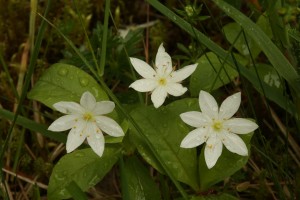
In comparison to my earlier visit, there were very few aphids on the dog rose plant, but after searching for quite a while I did manage to find a couple of adults, which I photographed and then sent to Ed. However, he’s not yet been able to make a positive identification of them. Nearby the dog rose, there were quite a lot of chickweed wintergreen plants (Trientalis europaea) in flower – they always mark the transition from spring flowering plants in the forest to the summer ones.
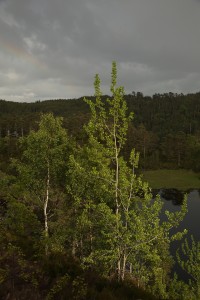
By now it was time to head for home, so I stopped at the Loch Beinn a’Mheadhoin overlook to get a wider view of the landscape in this part of the glen.
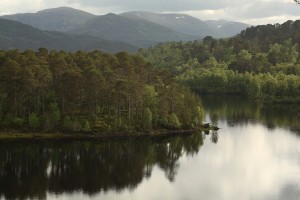
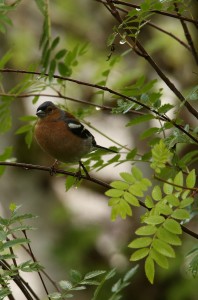
After enjoying the view there, during which I caught a glimpse of a faint rainbow over some of the trees, I drove back to the Dog Falls car park area, where I was hoping to see some birds. Chaffinches (Fringilla coelebs) in particular have been become habituated to the presence of visitors there, and wait around the picnic tables, looking for easy pickings of free food. It provides a good opportunity to get some photographs of what is the commonest bird in the Caledonian, and soon after I arrived I spotted a pair of birds in the young trees around one of the tables. By this time it was quite late in the day, so most of the visitors had left, and there were fewer birds than I’ve seen on other occasions. However, when I waited quietly for a few minutes, the pair of chaffinches came quite close, and I was able to get a few images of them. They however were rather disappointed as they didn’t get any food from me.
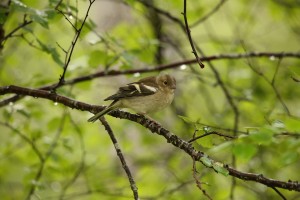
I had mixed feelings about taking advantage of these birds’ opportunistic behaviour. I don’t support feeding wild birds in a National Nature Reserve like this, where the objective is for Nature to take care of itself. Yet, here I was benefitting from that very behaviour, by taking the easy option to get some photographs that otherwise would be much harder and more time-consuming to obtain. So, I just smiled at the birds and appreciated them, without giving them any food myself.
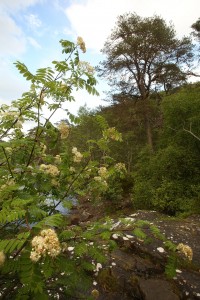
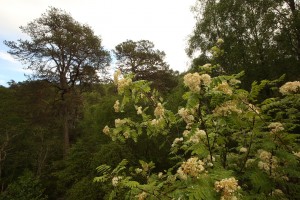
While I was watching the birds I noticed the bright flowers of a young rowan tree (Sorbus aucuparia) beside the Affric River, so I wandered over to have a closer look. The rowan was at the peak of its flowering, with the corymbs, or flower clusters, bending the branch tips downwards with their weight. Each corymb has up to 250 individual blossoms in it, and these are pollinated by flies, bees and beetles.
This was a good final stop for my day, and as I set off for home, I realised that although I had seen enough of interest to fill two blogs like this, I had never ventured further than 50 metres or so from my car during the entire day. This meant that I had got some exercise, which was good for my leg in terms of recovery from the sciatica, but I hadn’t overdone it, so I left for home feeling well-satisfied with my endeavours.
Thank you Alan for these fascinating adventures. Is the mating of the leaf weevil particular to this time? Is that why you saw so many of them?
I am looking forward to reading your next blog.
Hi Pupak,
Thanks for your comment. Yes, those weevils typically breed at this time of year – I photographed them mating on the same aspen saplings on 8th July 2013.
With best wishes,
Alan